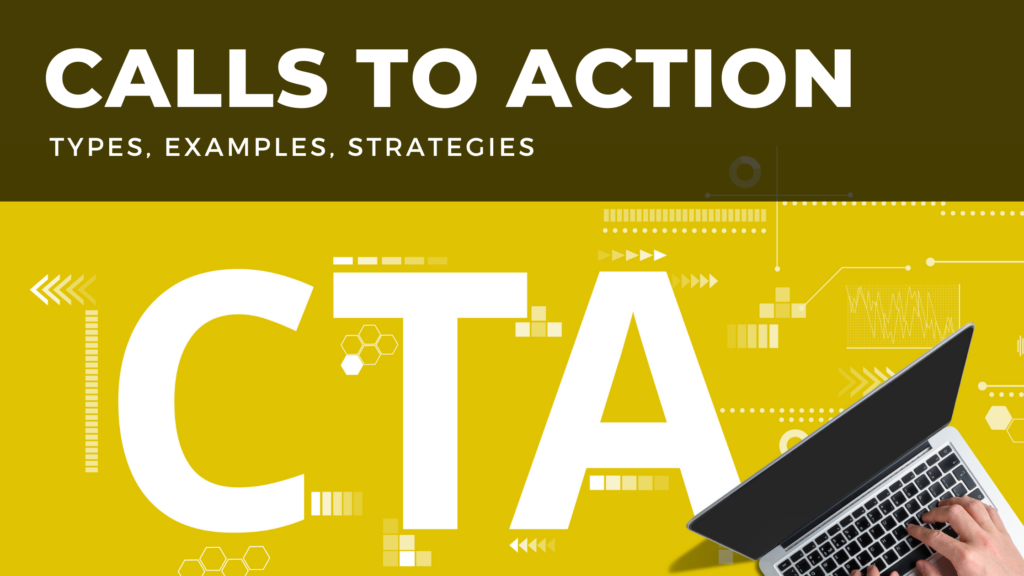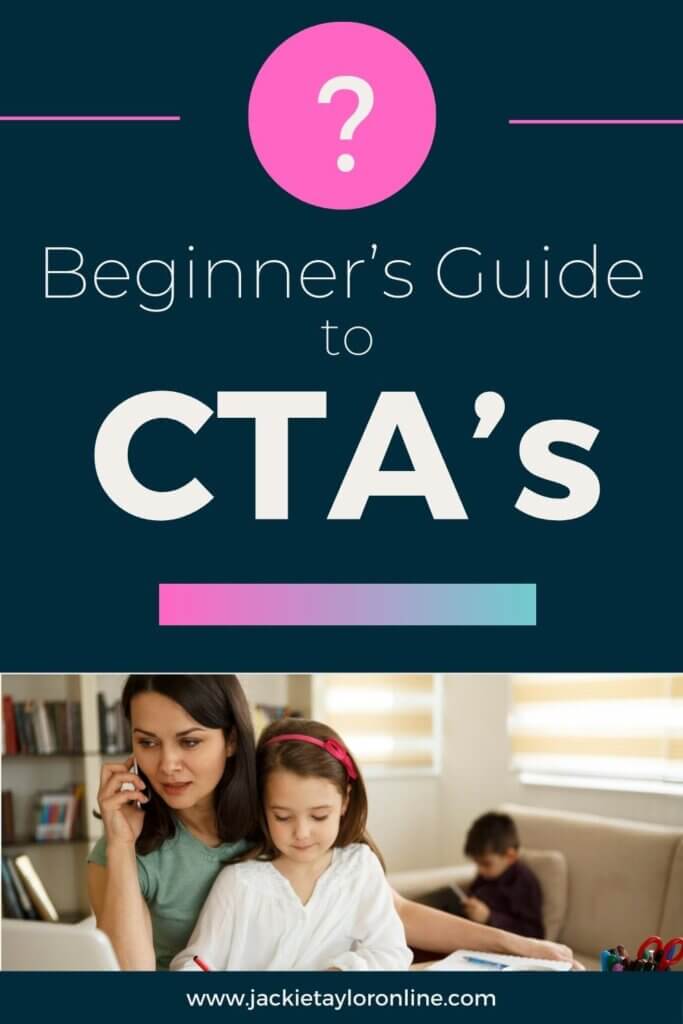“Buy now!” or “Sign Up Today!” These are different types of CTAs or Call to Actions. They’re used to persuade and motivate users to take desired actions. This guide is here to help in two main ways. 1. Help fix any confusion about how to get started with CTAs. 2.) Help you create a better strategy for optimizing your existing CTAs.
Let’s dive into all you need to know about using CTAs. Including what they are, their benefits, and how to create effective CTAs. We’ll also tackle best practices, and when to use all the different types of CTAs.
AFFILIATE DISCLAIMER: I SOMETIMES LINK TO PRODUCTS AND SERVICES TO HELP COVER THE COSTS OF RUNNING THIS BLOG. THERE’S NO EXTRA COST TO YOU – AND I ONLY RECOMMEND PRODUCTS THAT I’VE BOTH USED PERSONALLY AND THINK ARE QUALITY PRODUCTS THAT HELP WITH EFFICIENCY. PLEASE READ MY AFFILIATE DISCLOSURE FOR MORE INFORMATION. THANKS FOR YOUR SUPPORT!

Table of Contents
- What is a CTA?
- Benefits of Using CTAs
- Tips to Create an Effective CTA
- Best Practices for Creating Call to Actions That Work
- Types of CTAs
- Call to Action Examples
- Strategies for Optimizing Your CTA Performance
- Tips for Increasing Conversion Rates with Your CTAs
- Wrapping Up: What You Need to Know About Using Different Types of CTAs

What is a CTA?
CTAs are elements on a web page that prompt a user to take a specific action. Every piece of content that you create and post online should include a call to action. Your call to cation needs to be direct, simple, and to-the-point. CTAs usually take the form of buttons, text links, forms, pop-ups, or slides-ins. With the right wording, design, and placement for your CTA, you can increase user engagement and generate more leads and conversions.
When creating a CTA, it’s important to consider the buyer’s journey. What action do you want them to take? What is the goal of the CTA? What is the benefit to the user?
An effective call to action should be tailored to the buyer’s needs and should be placed in a prominent location on the page. Additionally, it should be visually appealing and stand out from the rest of the page.
Think bright or bold colors that stand out from the rest of your brand colors. And even bold fonts that are easy to read.
CTAs are an important part of any website or marketing campaign. They can help to increase user engagement, generate leads, and drive conversions.
With the right wording, design, and placement, you can create an effective CTA that will help to increase user engagement and generate more leads and conversions.

Benefits of Using CTAs
One of the main benefits of using CTAs is that they can help you increase website conversions. They give users an easy way to take the action you want them to take.
When placed strategically on a website, CTAs can streamline the user’s journey and guide them towards completing a desired action. Having effective CTAs in place can also drive more shareable traffic and improve overall user engagement.
CTAs can also be used to increase brand awareness and recognition. By using CTAs, you can direct users to specific pages on your website, such as product pages or blog posts.
This can help to increase the visibility of your brand and create a more memorable experience for users. You can also create a call to action that encourages users to sign up for your newsletter or follow you on social media, which can help to build a larger and more engaged audience.
By tracking the performance of your CTAs, you can gain valuable insights into how users are interacting with your website. This can help you to identify areas of improvement and optimize your website for better user experience and higher conversions.
Related Article: 40+ Online Marketing Resources: You Don’t Want to Miss
Tips to Create an Effective CTA
When creating a call to action that’s effective and helps to increase your click through rate and conversions, you want to think about these key areas:
- Use concise, short messaging.
- Keep the language simple and make sure that users know exactly what action they are being asked to take.
- Use active language that stands out. (Buy, subscribe, follow are all active language.)
- Emphasize the benefit the user will get by taking the desired action. For example, don’t just say ‘sign up’; instead try “Grow my audience.” Grow is active voice, and grow my audience highlights the benefit, not just the action of clicking a button.
- Make sure the CTA stands out from other elements on the page by using different colors, shapes, or sizes.
- Make your call to action visible and easy to find. Place it on your post or page in an easy to find and spot.
- Consider the buyer’s journey and place the CTA at the most logical point in the buying process. For example, if you’re asking users to sign up for a newsletter, place the CTA at a point where they’ve had some time to get to see what content or benefits you provide. This will give them an insight into what they would get by signing up for the newsletter.
Best Practices for Creating Call to Actions That Work
When creating a Call to Action, start by making sure the message is clear and concise. Include action words that tell the user exactly what you want them to do and make sure the CTA is easily visible on the page (for example, it should be contrasting in color from the background).
It can also help to make your CTA stand out by using images or icons.
It’s also important to consider the placement of your CTA. Make sure it is placed in an area of the page that’s easily accessible and visible to the user. Also, consider the length of your CTA. Keep it short and to the point, so that the user can quickly understand what action they need to take.
Finally, consider the timing of your CTA. If you are asking the user to take an action, make sure it’s at the right time in the buyer’s journey.
For example, if you are asking the user to sign up for a newsletter, make sure they have had enough time to explore the website and understand the value of the newsletter before you ask them to sign up.

Types of CTAs
CTAs come in many different forms. Popular forms include buttons, text links, forms, slide-ins, pop-ups, and inline CTAs.
- Call-to-Action Button: This is the most common type of CTA and consists of a clickable button with text or an image.
- Text Link CTAs: This type of CTA consists of a clickable link on your webpage or in an email which redirects users to a landing page or another page on your website.
- Slide-in CTAs: Slide-in CTAs are smaller than traditional call-to-action buttons and appear at the edge of the screen. They usually appear when the user has already scrolled down the page.
- Pop-up CTAs: Pop-up CTAs appear as a pop-up box in front of any other content on the page. They usually appear after a period of time has passed on the page or when users are about to exit.
- Inline CTAs: Inline CTAs consist of a piece of text that links to another page on the website.
It is important to consider the placement of your CTAs when designing your website. CTAs should be placed in prominent locations on the page, such as the top or bottom of the page, or in the middle of the page. Additionally, CTAs should be placed in areas where users are likely to take action, such as near the end of a blog post or at the end of a product page.
Related Article: Customer Research Methods: 4 Ways to Get Inside Your Audience’s Mind
Call to Action Examples
If you want Call to Action examples. Here are 10 easy to use and understand CTAs. You can start using them in your content today.
Whatever you use for your call to action, try to make sure you follow the tips outlined here, and always track the results to see what works best for your particular audience, as well as for the different types of campaigns that you launch. Because there are many things that can change what type of CTA works best.
- Shop now or buy now
- Sign up for our newsletter
- Get a free trial
- Join our community
- Follow for More
- Learn More
- Contact us today
- Limited time offer – act now!
- Download our app
- Subscribe to our channel
- Grow online or grow your audience
- Steal this!
- Swipe my [your freebie]
- Limited quantities available!
- Act today!
- Get started
- Add to wishlist
- Reserve your spot now!
- Take the quiz now
- Free instant access
Strategies for Optimizing Your CTA Performance

To get the most out of your CTAs, it’s important to constantly optimize and test them. Some strategies for optimizing CTAs include:
- Testing different CTA designs and placements on your website
- Tracking what types of CTAs are resulting in more clicks
- A/B testing different versions of your copywriting
You should also consider the context of your Call to Action. For example, if you’re running a promotion, you may want to include a CTA that encourages people to take advantage of the offer.
Additionally, you should consider the timing of your CTA. If you’re running a limited-time offer, you may want to include a CTA that emphasizes the urgency of the offer.
Tips for Increasing Conversion Rates with Your CTAs
To increase your conversion rates with your CTAs, start by making sure they stand out so they can be easily seen by users.
Use strong language that clearly communicates what action you want the users to take. If you don’t tell them specifically what they need to do next, they won’t know. Don’t leave your audience guessing. Tell them what steps to take next.
Also make sure your Call to Actions are visible on all devices (desktop, mobile, tablet – test them all!), since more and more people are using mobile devices for web browsing.
Finally, constantly monitor and adjust your CTAs to ensure that they are still relevant and up to date.
It is also important to consider the placement of your CTAs. Make sure they’re placed in areas of the page or social media post that are easily visible and accessible. This will help you to optimize your CTAs and ensure that they are as effective as possible.
Related Article: The Buyers Journey: How to Create Content That Guides Your Audience to Purchase

Wrapping Up: What You Need to Know About Using Different Types of CTAs
Using CTAs can help you capture more leads and boost conversions on your website or in email campaigns. Understanding how to write and optimize effective CTAs for different types of users is key for success.
In this guide we looked at what CTAs are, their benefits, how to create effective ones, best practices for writing them, different types of CTAs and when to use them, strategies for optimizing their performance, and tips for increasing conversion rates with them. Following all these tips should help you create highly successful CTAs that drive more conversions than ever before.
It’s important to remember that CTAs are not a one-size-fits-all solution. Different types of CTAs work better for different types of users and different types of campaigns.
Experimenting with different Call to Action types and testing them to see which ones work best for your audience is the best way to ensure success.
Additionally, it’s important to keep track of your CTA performance and adjust your strategy as needed. This will help you maximize the effectiveness of your call to action and ensure that you’re getting the most out of them.
By understanding the different types of CTAs and how to create and optimize them, you can create highly effective CTAs that will help you capture more leads and boost conversions.
With the right strategy and some experimenting, you can create call to actions that’ll help you reach your goals and drive more success for your business.

+ show Comments
- Hide Comments
add a comment